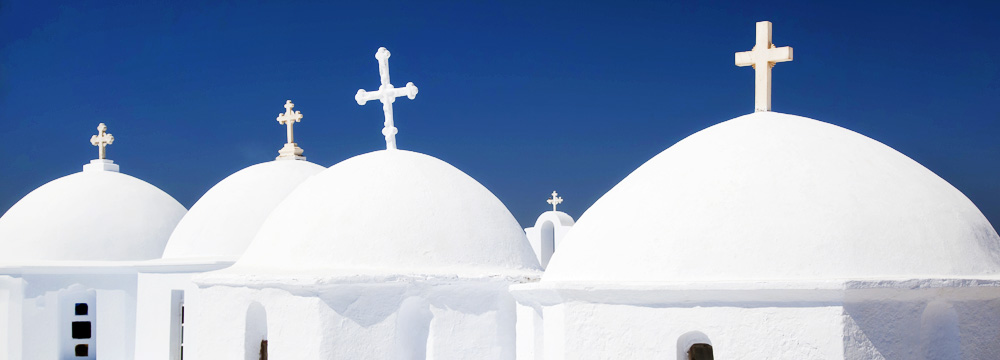Hora is the capital of the island. You can tour around the narrow cobbled streets, admire the old traditional mansions, the whitewashed churches and you will also have the chance to visit the hill with the windmills offering fascinating views of the Aegean Sea. The streets lead to Loza and the old Castle right at the highest spot in the middle of the settlement. In the old mansion of Gavras one can find historical findings from the island.
Standing gracefully right above Hora, the Venetian Castle resembles mostly a huge rock mass with fortification walls that dates back to the 13th century, built by Ieremias Gizis in order to protect the island’s main settlement for invasions. Naturally, the castle offers breathtaking views to the majestic scenery of Hora and the Aegean Sea.
To enter the monastery one has to ascend 300 stairs. It is built in a beautiful rough place over steep rocks, literally hanging over the void. It was constructed in 1088 and was renovated by the Emperor of the Byzantium Aleksios Komninos.
According to the tradition the reason for its construction was the image of Holy Mary found on the spot, which originally came from Hozovo (or Hozova) of Palestine during the persecution of Christians in the 9th century. Architectural interventions and changes that altered its prime character were made during the Venetian Rule (1296-1537).
During the Turkish Rule (1537-1824) the monastery managed to keep its state of prosperity due to its big fortune (including lands in Crete, Naxos, Paros, Astypalaia, Ios, Leros and other islands).
This served as a medieval cistern providing water to the population of Hora during the Byzantine Era. Nowadays its form is like a cave with a water pool which was finalized during the Venetian times.
Right next to Katapola, this ancient town, you will meet the ruins of the ancient town “Minoa”, believed to have been named after King Minoa of Crete, as he is thought to have ruled on Amorgos too. Various findings and the ruins of a settlement prove that this was one important town hundreds of years ago. A stroll through the ruins and the aura of the past will take you over here too as in most archeological sites in Greece.
Various legends and stories are wrapped around this Post Byzantine monastery which was built on the remnants of an ancient church of the 9th century A. D. and is found near the famous Panagia Hozovotissa Monastery. It is believed that lepers that managed to escape from a pirate ship made their way out here from Hora and found a natural water spring with mint growing all around it. After they settled here, their illness disappeared and since a holy icon of St. George was found there, the monastery was built to honor the saint and the miracle.
Apart from that, the spring is known to have had miraculous healing properties during the pre-Christian times and its waters flow till nowadays in the middle of the monastery. The priests here claim that they can read a person’s destiny for a glass of water following unwritten rules passed from generation to generation. For trekking lovers, a path from the Monastery leads to the ancient city of Minoa.
A superb building of Venetian architecture dating back to the 16th century houses today the archeological collection of the island of Amorgos. The exhibits vary from the Copper Age objects to utensils and findings till the ancient times. On the ground floor you will mostly find prehistoric objects and in the first floor you will see sculptures and other art objects.
On Amorgos you will find many towers dating back to the Hellinistic Period but the one found on the south of the island, in Arkesini, is among the most important and well-standing ones. It is believed to have been built during the 4th century B.C. and despite its wrecked appearance you can make out that it had a proper cistern and a kind of plumbing system.
This is a very important sample of early Byzantine times found within an hour’s walk from Lagada village near Aegiali. The natural surroundings are amazing while the monastery is built on the ruins of an ancient temple. Twice each year a great festival takes place here in May 8th and September 26th. Nearby you can also find the church of Stavros through paths carved within the wild nature.
Another great sample of religion and faith, Panagia Katapoliani is found in Katapola and has been built on the ruins of an ancient temple and this is most probably the reason why it is attributed to Apollo the Pitheios. The church is also a marvel of Cycladic architecture.
A plain structure completely attuned with the environment with a length of 40m, 5m wide and 8 floors high with narrow stone-made stairs leading up to them.
Stones from Milos Island and timber were used to the construction of this building used as a monastery. The monastery consists of the monk cells, the cuisines, the ovens, the warehouses, the bakery, the treadle, the cellars, the wells.
The Altar is open to the public on the 21th of November, the celebration day of Virgin Mary.
Also, since 1977, three small cells were united for the visitors to see so that they admire some of the relics of this monastery with the treat of citron and loukoumi sweets.
Nikouria nowadays is an uninhabited islet, located 300 metres from the coast Agios Pavlos, and can be visited by boat from there. According to the findings it was inhabited since the 3rd millennium B.C. and, also, it served as a mine and currency construction site for the ancient towns of Minoa, Aegiali and Arkesini. It has three unspoiled beautiful beaches with sand and pebbles as well, for all tastes. The waters there are cold, clean and crystal clear.








 BACK TO LIST
BACK TO LIST